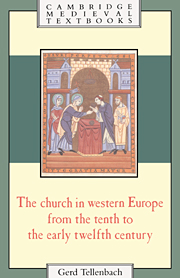Book contents
- Frontmatter
- Contents
- Translator's note
- Author's preface
- List of abbreviations
- 1 Western Christendom and its environment in the tenth and eleventh centuries
- 2 The church and its manifestations on earth
- 3 The material existence of the churches and the clergy
- 4 Religious life and thought
- 5 The beginnings of the revolution in church history
- 6 Gregory VII (1073–1085)
- 7 Continuing conflicts between established principles
- 8 Pope, church, and Christendom
- Epilogue
- Select bibliography
- Index
- Cambridge Medieval Textbooks
6 - Gregory VII (1073–1085)
Published online by Cambridge University Press: 05 June 2012
- Frontmatter
- Contents
- Translator's note
- Author's preface
- List of abbreviations
- 1 Western Christendom and its environment in the tenth and eleventh centuries
- 2 The church and its manifestations on earth
- 3 The material existence of the churches and the clergy
- 4 Religious life and thought
- 5 The beginnings of the revolution in church history
- 6 Gregory VII (1073–1085)
- 7 Continuing conflicts between established principles
- 8 Pope, church, and Christendom
- Epilogue
- Select bibliography
- Index
- Cambridge Medieval Textbooks
Summary
THE GROWTH OF PAPAL ACTIVITY FROM LEO IX TO ALEXANDER II
Until the middle of the eleventh century the history of the Roman church had had a largely provincial character, with occasional periods of wider significance. The general theoretical recognition of the pope's religious supremacy was not even sufficient to enable him to exercise jurisdiction in his own ecclesiastical province, let alone in the whole of Italy. The churches in the localities led their own life and could easily avoid being dominated by the head of the church in a politically divided land. Often it was only with difficulty that the popes could retain or recover the possessions of the Roman church. Besides periods of weakness and dependence on local and distant powers there were also times when the popes took on a leading political and military role in Italy. We may concede that such political activities were seen as means to spiritual ends, but they showed repeatedly that the popes were not able to exist as purely spiritual leaders even in their own immediate sphere. The typical duality of spiritual and political and material existence which is characteristic of the church on earth appears as a dilemma to the religious mind even at the highest level of Christendom.
After the decisive events of Henry III's reign the Roman church began to extend its influence over the churches in the localities, but gradually and by no means continuously; there were advances and retreats.
- Type
- Chapter
- Information
- Publisher: Cambridge University PressPrint publication year: 1993



